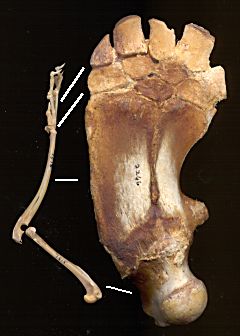

The Germans had a word for it, Bauplan, meaning an architectural plan. For animals, that meant a basic common blueprint shared by different kinds. For example, all land vertebrates share a basic body plan that has been modified by differences in sizes and proportions and by fusions and losses.
The limbs of these tetrapods show this clearly: a single upper bone
followed by a pair farther down, then a cluster of wrist or ankle bones, followed by
the elongated bones of the palm of the hand or arch of the foot, and finally, fingers
and toes. This Bauplan is variously altered, but still recognizable, whether in the
wings of bats, birds, or extinct flying reptiles; the flippers of porpoises or
penguins; the single forearm bone of a camel formed by fusion, or the single toe of the
horse. Evolution can go even further, with snakes and some lizards with no limbs at
all, but their other characteristics make it clear that these are just a continuation
of losses carried out one more step—or perhaps we should say one more
"slither".

Contributor: Arthur H. Harris, Laboratory for Environmental Biology, Centennial Museum, University of Texas at El Paso.
Desert Diary is a joint production of the Centennial Museum and KTEP National Public Radio at the University of Texas at El Paso.

Comparison of the forelimb of a Desert Cottontail rabbit (Sylvilagus audubonii) on the left and a porpoise (Delphinus) forelimb on the right. The lines point to homologous parts of the forelimbs, from bottom to top: humerus, radius and ulna, carpals (wrist bones), and metacarpals (bones lying between the wrist and the fingers); the fingers are missing from this particular specimen of porpoise.
Strickberger, M. W. 2000. Evolution. Jones and Bartlett Publishers, third edition, Boston, 721 pp.
Comparisons of several forelimbs by BIODIDAC.